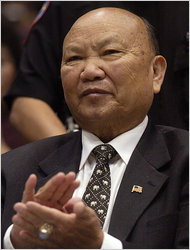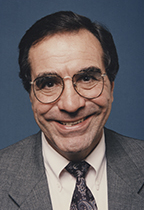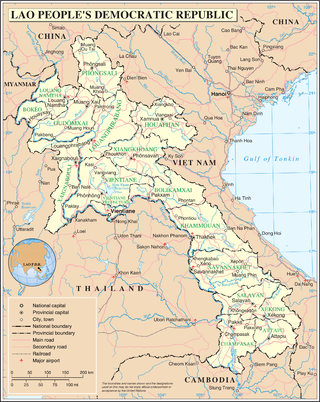Related Research Articles

The Hmong people are an indigenous group in East Asia and Southeast Asia. In China, the Hmong people are classified as a sub-group of the Miao people. The modern Hmong reside mainly in Southwest China and Mainland Southeast Asian countries such as Vietnam, Laos, Thailand, and Myanmar. There is also a large diasporic community in the United States of more than 300,000. The Hmong diaspora has smaller communities in Australia and South America.

Vang Pao was a major general in the Royal Lao Army and later a leader of the Hmong American community in the United States.

The Laotian Civil War was waged between the Communist Pathet Lao and the Royal Lao Government from 23 May 1959 to 2 December 1975. The Kingdom of Laos was a covert theater during the Vietnam War with both sides receiving heavy external support in a proxy war between the global Cold War superpowers. The fighting also involved the North Vietnamese, South Vietnamese, American and Thai armies, both directly and through irregular proxies. The war is known as the Secret War among the American CIA Special Activities Center, and Hmong and Mien veterans of the conflict.

Bruce Frank Vento was an American educator and politician, a Democratic-Farmer-Labor member of the United States House of Representatives from 1977 until his death in 2000, representing Minnesota's 4th congressional district.
Wat Tham Krabok is a Buddhist temple (wat) in the Phra Phutthabat District of Saraburi Province, Thailand.

Hmong Americans are Americans of Hmong ancestry. Many Hmong Americans immigrated to the United States as refugees in the late 1970s. Over half of the Hmong population from Laos left the country, or attempted to leave, in 1975, at the culmination of the Laotian Civil War.
The insurgency in Laos is a low-intensity conflict between the Laotian government on one side and former members of the Secret Army, Laotian royalists, and rebels from the Hmong and lowland Lao ethnic minorities on the other. These groups have faced reprisals from the Lao People's Army and Vietnam People's Army for their support of the United States-led, anti-communist military campaigns in Laos during the Laotian Civil War, which the insurgency is an extension of itself. The North Vietnamese invaded Laos in 1958 and supported the communist Pathet Lao. The Vietnamese communists continued to support the Pathet Lao after the end of the Laotian Civil War and the establishment of the Lao People's Democratic Republic. At least 100,000 Hmong civilians were killed as the result of Laotian governmental policies, in what has sometimes been referred to as the Hmong genocide.

The Hmong and Lao Memorial, or Lao Veterans of America Monument, is a granite monument, bronze plaque and living memorial in Arlington National Cemetery in the US. Dedicated in May 1997, it is located in Section 2 on Grant Avenue between the path to the JFK memorial and the Tomb of the Unknowns, in Arlington National Cemetery, Arlington, Virginia, in the United States. The Laos–Hmong memorial commemorates the veterans of the "Secret War" in Laos who fought against invading Soviet Union-backed North Vietnam Army forces of the People's Army of Vietnam and communist Pathet Lao guerrillas. Approved by the U.S. Department of Defense, Arlington National Cemetery, and the U.S. Department of the Army, but designed and paid for privately by the Lao Veterans of America, Inc., the Lao Veterans of America Institute, and The Centre for Public Policy Analysis, the memorial stands as a tribute to the Hmong, Lao, other ethnic groups, and American clandestine and military advisers who made up the Secret War effort during the Vietnam War. The Lao Veterans of America, Inc. is the nation's largest ethnic Laotian- and Hmong-American veterans organization.

The alleged 2007 Laotian coup d'état plan was a conspiracy allegation by the United States Department of Justice that Lt. Col. Harrison Jack (Ret.) and former Royal Lao Army Major General Vang Pao, among others conspired in June 2007 to obtain large amounts of heavy weapons and ammunition to overthrow the Communist government of Laos in violation of the Neutrality Act. The charges were ultimately dropped and the case helped serve to further highlight, instead, major human rights violations by the Lao government against the Hmong ethnic minority, Laotian refugees, and political dissidents.

Relations between Laos and the United States officially began when the United States opened a legation in Laos in 1950, when Laos was a semi-autonomous state within French Indochina. These relations were maintained after Laos' independence in October 1953.
Vang Pobzeb was a Hmong American dedicated to Lao and Hmong human rights. For over 25 years, he was an outspoken critic of the Marxist governments of the Pathet Lao in Laos and the Socialist Republic of Vietnam (SRV) and their human rights violations, religious freedom violations, and persecution of the Lao and Hmong people.
The Center for Public Policy Analysis (CPPA), or Centre for Public Policy Analysis, was established in Washington, D.C., in 1988 and describes itself as a non-profit, non-partisan, think tank and research organization. The CPPA is a non-governmental organization (NGO) focused on foreign policy, national security, human rights, refugee and international humanitarian issues. Its current executive director is Philip Smith.
The Lao Veterans of America, Inc., describes itself as a non-profit, non-partisan, non-governmental, veterans organization that represents Lao- and Hmong-American veterans who served in the U.S. clandestine war in the Kingdom of Laos during the Vietnam War as well as their refugee families in the United States.
The Lao Human Rights Council, Inc. (LHRC) is a non-profit, non-partisan, non-governmental (NGO) refugee and human rights organization. It is based nationally, and internationally, with chapters in Colorado, Wisconsin and Minnesota. The Lao Human Rights Council, Inc. researches, and provides information and education regarding the plight of Laotian and Hmong people, and refugees persecuted in Laos, the Socialist Republic of Vietnam and Thailand. It was founded by Dr. Pozbeb Vang, Vang Pobzeb of Greenbay Wisconsin. The Lao Human Rights Council, Inc. is currently headed by Vaughn Vang, an educator, and former political refugee from the Royal Kingdom of Laos, who is a Hmong-American—and who was born, and grew up, in Laos prior to the North Vietnamese invasion of Laos and Marxist takeover in 1975.
The Hmong are a major ethnic group in Fresno, California. The Fresno Hmong community, along with that of Minneapolis/St. Paul, is one of the largest two urban U.S. Hmong communities. As of 1993 the Hmong were the largest Southeast Asian ethnic group in Fresno. As of 2010, there are 24,328 people of Hmong descent living in Fresno, making up 4.9% of the city's population.
Cherzong Vang was an American community leader from St. Paul, Minnesota. He was an elder of the Hmong people in Laos and the Lao-American community in the Twin Cities of the United States.

Wangyee Vang is a Hmong-American community leader, educator and elder from Fresno, and the Central Valley, of California.
The Lao Veterans of America Institute (LVAI) is a national non-profit organization based in Fresno, and the Central Valley, of California, with chapters throughout California. It is one of the largest ethnic Lao- and Hmong-American veterans organizations representing tens of thousands of Lao Hmong veterans who served in the Vietnam War in the Royal Kingdom of Laos as well as their refugee families who were resettled in the United States after the conflict.

Ban Phou Pheung Noi is a Laotian village located at the peak of Phou Pheung mountain in the Xieng Khouang province of Laos. Phou Pheung mountain is approximately 916 m (3,005 ft). During the Vietnam War, combat between the American allies, the Hmong, and the Pathet Lao, The Laos Marxist government, and the Communist North Vietnamese People's Army took place on the mountain. Phou Pheung mountain runs from east to west and is rocky, and is covered in tropical forests. It is south of Muang Soui - Nongtang-Nato, and west of Phou Douk, Muang Phuan, Phonsavan and Plain of Jars. To the east, about 10 miles from Ban Phou Pheung Noi, is the Num Ngum 4 hydroelectric dam.
References
- ↑ "Hmong Veteran's Naturalization Act of 2000". ailc.com. American Immigration Law Center. Archived from the original on 8 April 2013. Retrieved 1 October 2014.
- ↑ Lao Veterans of America, Inc., Washington, D.C., http://www.laoveteransofamerica.org Archived 2016-12-27 at the Wayback Machine
- ↑ Center for Public Policy Analysis, Washington, D.C.
- ↑ Davis, Charles, Washington Times, Washington, D.C.,(24 August 1997), "Repaying a Debt" [ dead link ]
- ↑ Smith, Mary Lynn, Star Tribune (Minneapolis, Minnesota), (11 May 1997), "Hmong veterans from Twin Cities heading to D.C. to attend tribute; Refugees back bill to ease citizenship requirements" "Hmong veterans from Twin Cities heading to D.C. To attend tribute; Refugees back bill to ease citizenship requirements.(NEWS) - Star Tribune (Minneapolis, MN) | HighBeam Research". Archived from the original on 2015-03-29. Retrieved 2014-11-28.
- ↑ Baca, Maria Elena, Star Tribune (Minneapolis, Minnesota),(23 June 1998), "Hundreds rally for bill" "Hundreds rally for bill.(NEWS) - Star Tribune (Minneapolis, MN) | HighBeam Research". Archived from the original on 2015-03-29. Retrieved 2014-11-28.
- ↑ States News Service, (16 May 2000) "Laos Hmong Veterans: Waive U.S. Citizenship Test Language." "LAOS HMONG VETERANS: WAIVE U.S. CITIZENSHIP TEST LANGUAGE. - States News Service | HighBeam Research". Archived from the original on 2015-03-29. Retrieved 2014-11-28.
- ↑ Barber, Ben, Washington Times, (15 May 1998) "Hmong Army Veterans Ask for U.S. Citizenship" [ dead link ]
- ↑ Frommer, Fred, Associated Press (AP), Washington, D.C. (2 May 2000) "House Approves Hmong Citizen Bill" "House Approves Hmong Citizen Bill - AP Online | HighBeam Research". Archived from the original on 2015-03-29. Retrieved 2014-11-28.
- ↑ Asia Week "House Committee Approves Easier Citizenship Rules for Hmong, Laotian Vets" (12 April 2000) "Briefs: House Committee Approves Easier Citizenship Rules for Hmong, Laotian Vets - AsianWeek | HighBeam Research". Archived from the original on 2015-03-29. Retrieved 2014-11-28.
- ↑ Sewell, Chris, The Capital Times, Madison, Wisconsin, (20 May 2000), "Hmong Vets Get Break in Citizenship" "HMONG VETS GET BREAK IN CITIZENSHIP.(HomeGarden) - the Capital Times | HighBeam Research". Archived from the original on 2015-03-29. Retrieved 2014-11-28.
- ↑ The Economist (29 November 2001), "They earned it: A last-minute reprieve for Hmong fighters seeking American citizenship." http://www.economist.com/node/886687
- ↑ Loeb, Vernon, Washington Post (15 October 2000)"CIA Figure Lobbies for Secret Warriors' Widows; Measure to Aid Naturalization of Lao and Hmong Spouses Is Lodged in Senate" http://www.highbeam.com/doc/1P2-555885.html Archived 2015-03-29 at the Wayback Machine
- ↑ The Economist, (1 December 2001)"They earned it; Hmong-Americans.(Citizenship for Hmong refugees)" "They earned it; Hmong-Americans.(Citizenship for Hmong refugees)(Brief Article) - the Economist (US) | HighBeam Research". Archived from the original on 2015-03-29. Retrieved 2014-11-28.
- ↑ Leary, William. "CIA Air Operations in Laos 1955-1974: Supporting the "Secret War"". CIA.gov. Central Intelligence Agency. Archived from the original on June 13, 2007. Retrieved 1 October 2014.
- ↑ Vang, Wangyee, Lao Veterans of America Institute, Fresno, California
- ↑ Smith, Philip, Lao Veterans of America, Inc., Washington, D.C. http://www.laoveteransofamerica.org Archived 2016-12-27 at the Wayback Machine
- 1 2 3 4 McCaffrey, Angela (2004–2005). "Hmong Veterans' Naturalization Act: Precedent for Waiving the English Language Requirement for the Elderly". Georgetown Immigration Law Journal. 19 (4): 495–505.
- ↑ Smith, Philip, Executive Director, Center for Public Policy Analysis, Washington, D.C. http://www.centreforpublicpolicyanalysis.org Archived 2017-09-23 at the Wayback Machine
- 1 2 Lao Veterans of America, Inc., Washington, D.C. http://www.laoveteransofamerica.org Archived 2016-12-27 at the Wayback Machine
- ↑ Aamot, Gregg, Star Tribune (Minneapolis, Minnesota), (18 August 1997) "Hmong putting American politics to work for them; From Minnesota, California and other states, unprecedented numbers of Hmong immigrants are learning how to benefit from democracy by wielding the power that lobbying Congress gives them.(NEWS)http://www.highbeam.com/doc/1G1-62614713.html Archived 2015-03-29 at the Wayback Machine "
- ↑ Star Tribune, Minneapolis, Minnesota, (15 May 1998) "Minnesota group swells the ranks of Lao veterans rally; Hundreds gathered to pay respects to the secret army of the Vietnam War. (NEWS)" "Minnesota group swells the ranks of Lao veterans rally; Hundreds gathered to pay respects to the secret army of the Vietnam War.(NEWS) - Star Tribune (Minneapolis, MN) | HighBeam Research". Archived from the original on 2015-02-06. Retrieved 2014-11-28.
- ↑ Frommer, Fred, Associated Press (AP) Washington, D.C., (10 October 2000) "Minnesota Rep. Bruce Vento Dies" http://www.mesothel.com/asbestos-cancer/mesothelioma/patient-profiles/vento_obit.htm Archived 2014-12-04 at the Wayback Machine
- ↑ Gordon, Greg, Star Tribune (Minneapolis, Minnesota),(12 June 1998) "House panel acts to help Hmong vets who fought for CIA gain citizenship." "House panel acts to help Hmong vets who fought for CIA gain citizenship.(NEWS) - Star Tribune (Minneapolis, MN) | HighBeam Research". Archived from the original on 2015-03-29. Retrieved 2014-11-28.
- ↑ Frommer, Fred, Associated Press (AP),(23 May 2000) "Hmong Citizenship Bill Passes Congress" "Citizenship Bill Passes Congress - AP Online | HighBeam Research". Archived from the original on 2015-03-29. Retrieved 2014-11-28.
- ↑ The Wisconsin State Journal,(Madison, Wisconsin), (24 May 2000) "Bill to Help Hmong Gets Final OK It Would Make It Easier For Many Laotians To Get U.S. Citizenship." "BILL TO HELP HMONG GETS FINAL OK IT WOULD MAKE IT EASIER FOR MANY LAOTIANS TO GET U.S. CITIZENSHIP.(Front) - the Wisconsin State Journal (Madison, WI) | HighBeam Research". Archived from the original on 2015-03-29. Retrieved 2014-11-28.
- ↑ Madigan, Sean, Star Tribune (Minneapolis, Minnesota) (27 May 2000) "Clinton signs citizenship bill for Hmong veterans".
- ↑ U.S. Congressional Record, "Honoring and commending the Lao Veterans of America, Laotian and Hmong veterans of the Vietnam War, and their families, for their historic contributions to the United States." https://www.congress.gov/bill/107th-congress/house-concurrent-resolution/406/text
- ↑ "Questions and Answers About the Hmong Veterans' Naturalization Act of 2000". oac.cdlib.org. Southeast Asia Resource Action Center. Retrieved 1 October 2014.
- ↑ Branigin, William, Washington Post (Washington, D.C.),(15 May 1997) "Recognizing U.S. Allies in `Secret War'; `Long Overdue' Honors Go to Hmong, Lao Vets" "Recognizing U.S. Allies in 'Secret War'; 'Long Overdue' Honors Go to Hmong, Lao Vets - the Washington Post | HighBeam Research". Archived from the original on 2015-03-29. Retrieved 2014-11-28.
- ↑ Barber, Ben, Washington Times, Washington, D.C., (14 May 1997) "Hmong Veterans to Receive Medals: Laotian People Became Refugees after Helping U.S. Fight Vietnam War" [ dead link ]
- ↑ Hamburger, Tom, Star Tribune (Minneapolis, Minnesota), (15 May 1997), "Hmong vets, who fought in secret, are honored; In the 1960s and '70s, Hmong soldiers aided the United States in its covert war in Laos. On Wednesday, Hmong veterans converged on the Vietnam Veterans Memorial in Washington to make sure they are not forgotten.(NEWS)" "Hmong vets, who fought in secret, are honored; in the 1960s and '70s, Hmong soldiers aided the United States in its covert war in Laos. On Wednesday, Hmong veterans converged on the Vietnam Veterans Memorial in Washington to make sure they are not forgotten.(NEWS) - Star Tribune (Minneapolis, MN) | HighBeam Research". Archived from the original on 2015-03-29. Retrieved 2014-11-28.
- ↑ Asia Week (29 May 1997), "Hmong Hold War Recognition in Washington" "Briefs: Hmong Hold War Recognition in Washington - AsianWeek | HighBeam Research". Archived from the original on 2015-03-29. Retrieved 2014-11-28.
- ↑ Social Security Administration, (13 June 2000) http://www.ssa.gov/legislation/legis_bulletin_061300.html
- ↑ Clinton, Bill. "Statement on Signing the Hmong Veterans Naturalization Act of 2000". ucsb.edu. University of California – Santa Barbara. Retrieved 1 October 2014.[ permanent dead link ]